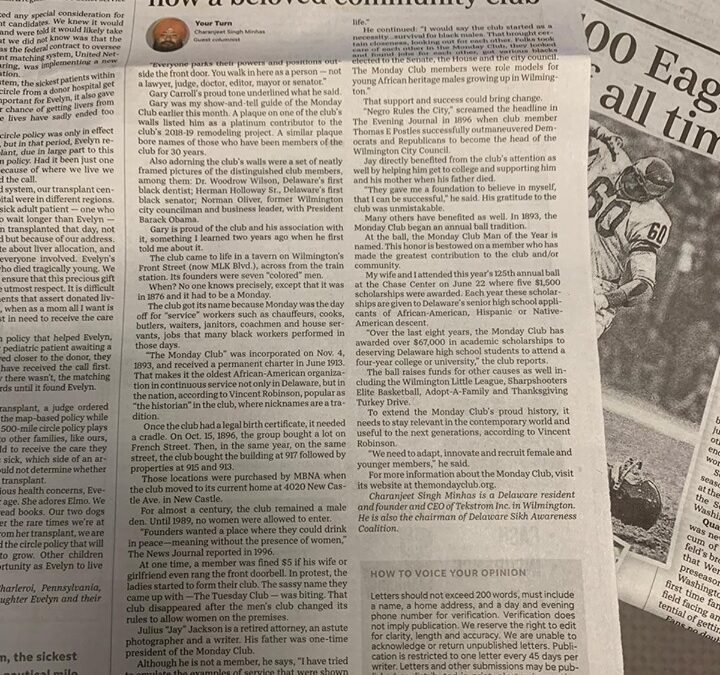
by blogadmin | Aug 12, 2019 | Blog Post, Delaware, Media Publishing's, Year 2019
“Everyone parks their powers and positions outside the front door. You walk in here as a person — not a lawyer, judge, doctor, editor, mayor or senator.”
Gary Carroll’s proud tone underlined what he said.
Gary was my show-and-tell guide of the Monday Club earlier this month. A plaque on one of the club’s walls listed him as a platinum contributor to the club’s 2018-19 remodeling project. A similar plaque bore names of those who have been members of the club for 30 years.
Also adorning the club’s walls were a set of neatly framed pictures of the distinguished club members, among them: Dr. Woodrow Wilson, Delaware’s first black dentist; Herman Holloway Sr., Delaware’s first black senator; Norman Oliver, former Wilmington city councilman and business leader, with President Barack Obama.
Gary is proud of the club and his association with it, something I learned two years ago when he first told me about it.
The club came to life in a tavern on Wilmington’s Front Street (now MLK Blvd.), across from the train station. Its founders were seven “colored” men.
When? No one knows precisely, except that it was in 1876 and it had to be a Monday.
The club got its name because Monday was the day off for “service” workers such as chauffeurs, cooks, butlers, waiters, janitors, coachmen and house servants, jobs that many black workers performed in those days.
“The Monday Club” was incorporated on Nov. 4, 1893, and received a permanent charter in June 1913. That makes it the oldest African-American organization in continuous service not only in Delaware, but in the nation, according to Vincent Robinson, popular as “the historian” in the club, where nicknames are a tradition.
Baltimore’s Arch Social Club earlier claimed the “most antique” tag until Vincent called them one day.
“Upon seeing the web page, I contacted the club and informed them of the Monday Club, Inc., and that their date of incorporation was 19 years later,” he said.
The Arch Social Club reacted to the news gracefully, Vincent said. A few weeks later it sent the Delaware club an invitation to visit, and eight members of The Monday Club drove to Baltimore for the fellowship opportunity.
Once the club had a legal birth certificate, it needed a cradle. On Oct. 15, 1896, the group bought a lot on French Street. Then, in the same year, on the same street, the club bought the building at 917 followed by properties at 915 and 913.
Those locations were purchased by MBNA when the club moved to its current home at 4020 New Castle Ave. in New Castle.
For almost a century, the club remained a male den. Until 1989, no women were allowed to enter.
“Founders wanted a place where they could drink in peace—meaning without the presence of women,” The News Journal reported in 1996.
At one time, a member was fined $5 if his wife or girlfriend even rang the front doorbell. In protest, the ladies started to form their club. The sassy name they came up with —The Tuesday Club — was biting. That club disappeared after the men’s club changed its rules to allow women on the premises.
Although women today remain frequent attendees, and even employees, there still are no females among the Monday Club’s 125 members.
Julius “Jay” Jackson is a retired attorney, an astute photographer and a writer. His father was one-time president of the Monday Club.
Although he is not a member, he says, “I have tried to emulate the examples of service that were shown to me by my father and other members of the club. I learned from an early age that I have an obligation to serve the community and make life better for others. I have tried to do this in my professional and personal life.”
He continued: “I would say the club started as a necessity…survival for black males. That brought certain closeness, looking out for each other. Folks took care of each other in the Monday Club, they looked and found jobs for each other, got various blacks elected to the Senate, the House and the city council. The Monday Club members were role models for young African heritage males growing up in Wilmington.”
That support and success could bring change.
“Negro Rules the City,” screamed the headline in The Evening Journal in 1896 when club member Thomas E Postles successfully outmaneuvered Democrats and Republicans to become the head of the Wilmington City Council.
Jay directly benefited from the club’s attention as well by helping him get to college and supporting him and his mother when his father died.
“They gave me a foundation to believe in myself, that I can be successful,” he said. His gratitude to the club was unmistakable.
Many others have benefited as well. In 1893, the Monday Club began an annual ball tradition.
At the ball, the Monday Club Man of the Year is named. This honor is bestowed on a member who has made the greatest contribution to the club and/or community.
My wife and I attended this year’s 125th annual ball at the Chase Center on June 22 where five $1,500 scholarships were awarded. Each year these scholarships are given to Delaware’s senior high school applicants of African-American, Hispanic or Native-American descent.
“Over the last eight years, the Monday Club has awarded over $67,000 in academic scholarships to deserving Delaware high school students to attend a four-year college or university,” the club reports.
The ball raises funds for other causes as well including the Wilmington Little League, Sharpshooters Elite Basketball, Adopt-A-Family and Thanksgiving Turkey Drive.
To extend the Monday Club’s proud history, it needs to stay relevant in the contemporary world and useful to the next generations, according to Vincent Robinson.
“We need to adapt, innovate and recruit female and younger members,” he said.
For more information about the Monday Club, visit its website at themondayclub.org.
– – – – –
This column was published online by the News Journal/Delawareonline.com on Monday, August 12, and printed in its Monday, August 12th edition.
Website Link: https://www.delawareonline.com/story/opinion/contributors/2019/08/12/opinion-once-refuge-black-men-now-beloved-community-club/1965620001/
Print Version:https://charanjeetsinghminhas.com/wp-content/uploads/2019/08/once_a_refge.jpg

by blogadmin | Jul 5, 2019 | Blog Post, Delaware, Media Publishing's, Year 2019
“What do you think of doctors?” I have been asked.
“A heartless tribe of professionals experienced in focusing on your wealth while pretending to care for your health,” has been my reply.
But one of the physicians here in Delaware changed my mind.
I have observed him closely for years. He and his wife are both internists in Wilmington and practice under Trinity Medical Associates.
His name is Vinod Kripalu, MD, but everyone calls him Vinny. She is Chetana Kripalu, MD, and everyone calls her that.
Vinny could be mistaken for a famine victim with his frail frame. But his meager physique is not the result of poor nutrition, just a seemingly inexhaustible energy. An avid runner, last December he kept going for over 26 hours until the 100-mile mark finally stopped him.
The Kripalus’ devotion and dedication to helping and serving the needy, however, is unstoppable.
In 2006, Vinny organized his first visible philanthropic effort through a “Brick by Brick” fundraiser. The twelve thousand dollars it raised were used to build a school in Kenya. In 2008, he and Chetana provided their services on a medical mission to Jamaica.
He also established two nonprofit organizations he still serves — the Delaware Medical Relief Team (DMRT) and Premiere Charities Inc. (PCI).
The medical relief team was created in 2009 after an earthquake devastated Haiti.
“We were the first team to go within a few days of the earthquake. DMRT sent out seven teams after Haiti and five after the Nepal earthquake,” he told me.
Their service also helps those closer to home. Each Sunday, rain or shine, From Our Kitchen, a program of PCI, provides food to the homeless and needy at Front and Lombard in Wilmington. The organization feeds about 180 people in each service and has provided more than 80,000 meals since 2009.
PCI has raised more than half a million dollars over the years and contributed each cent to several relevant local and global causes such as the fund for families of deceased local firefighters, help for families affected by diseases such as breast cancer, and aid for victims of a Pakistan earthquake.
I was among those who attended PCI’s fundraiser gala in April at The Waterfall banquet hall in Claymont. I watched in amazement and admiration as Vinny’s father, 93-year-old father, Thirumalachar Kripalu, danced with his daughter-in-law, Chetana.
Curious about the Kripalus’ impulse to help, I reached out to Thirumalachar to trace his son’s roots.
“I had a very tough childhood,” said Kripalu, a retired Indian army brigadier. “We were extremely poor, had nothing. Existence was becoming tough. As a kid, I started begging to earn something and would give it to my mom. This habit of sharing with others became a satisfying habit.”
Kripalu continued: “I was a major posted in the UK when Vinny was born there in 1964. I cannot say whether I influenced him, but one thing is certain: Chetana has a lot to do with his giving. She wanted to serve the needy even more.”
In August of 2015, Chetana and her daughter, Meera, along with Meera’s friend, Hannah, and a nurse traveled to Nicaragua to establish a health clinic.
“Chetana was the only doctor and worked long hours daily at the clinic in Pantanal, one of the poorest barrios in Nicaragua,” according to Chuck Selvaggio, executive director of Neighbors to Nicaragua, a Wilmington nonprofit. Meanwhile, Meera and Hannah volunteered at a nearby school, working with and feeding the children.
“Both Chetana and Vinny have been very supportive of our work, contributing time, financial support (paying for many of the medications given out at the clinic), and, most of all, encouragement and inspiration by example in the great work they do and the wonderful people they are,” Selvaggio said “Their lives are nothing less than a great gift to our community and all the people they serve worldwide.”
It takes a long time, lots of fortitude and some luck to succeed in doing good. Not many doctors like Vinny and Chetana envision “state of complete wellbeing” for their patients by “nurturing their body, mind, and spirit.”
It is fitting that their work reflects the meaning of their Indian names. In the case of Vinny and Chetana, their first names mean happiness (Vinod) and consciousness (Chetana). Kripalu means indulgent.
Maybe that’s why they are happily and consciously indulgent!
– – – – – – –
This column was published online by the www.delawareonline.com on July 03, 2019.
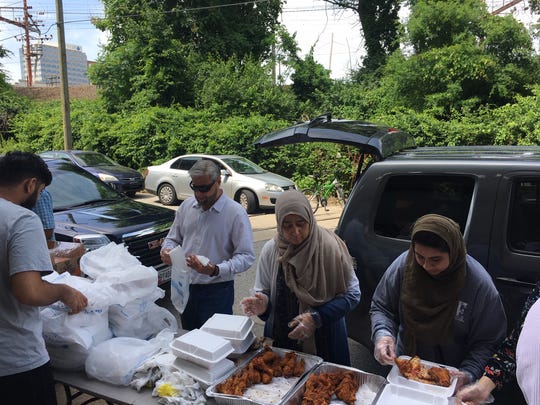
by blogadmin | May 29, 2019 | Blog Post, Delaware, Media Publishing's, Year 2019
You are not a Muslim. You have no Muslim friends. And you haven’t seen, read or heard anything positive about Muslims — ever. You never came across anything nonviolent and not disgusting about them.
Me neither!
No matter where I went, Muslims had always been in the news for the wrong reasons.
In India, the UK and even during my last 20 years here in the U.S., I have seen the anger and animosity against Islam and the Muslim communities only grow stronger and louder over the years. President Trump successfully rode it, among other things, to the White House.
I was home drinking tea in Dover on 9/11. In 2009, my wife and I, along with our two children, stayed at The Taj Palace Hotel in Mumbai, India where, only a year earlier a terrorist attack had killed 166 people.
Perpetrators in both cases were Muslims.
Internationally, we constantly hear about the barbaric and inhuman acts of Muslim terrorist groups like ISIS, the Taliban, Al Qaeda, Boko Haram, the Khorasan group, the Haqqani network and their offshoots.
An interfaith coalition distributes food to the homeless at Front and Lombard Street in Wilmington
Reaction to these groups and incidents often are quick and emotional. In Delaware, two Republican state senators
walked out of the Senate during a Muslim prayer in April 2017. The reason, one of them said, was that women and minorities are not treated fairly and respectfully by Muslims.
With no or negligible interaction with Muslims, does the negative barrage make us believe that all followers of Islam are constantly conspiring to commit evil? To explore that question, I launched a soul-sponsored expedition to discover the truth.
I asked Islamic Society of Delaware’s (ISD) interfaith chair Irfan Patel for his reaction to the senator’s allegation. “His actions show lack of understanding of our faith,” he said. “Islam teaches equal rights to men and women. In fact, laws of inheritance are a prime example of how women’s rights are respected in Islam. To give some context, women were not given electoral rights in many western societies until recently.”
I am a Sikh. Delaware’s second gurdwara (Sikh temple) opened in the summer of 2015 in Middletown. Weeks after, I organized an interfaith peace prayer there in August to mark the third anniversary of the Oak Creek, Wisconsin gurdwara killings.
We had decided on one speaker from one house of worship for the event. But, a couple of days before the meeting, I received a call from a stranger who turned out to be a professor at the University of Delaware.
He dispelled my “only one mosque” assumption. “There isn’t only one, not even two, but seven mosques in New Castle County,” he enlightened me. And Patel confirmed there are in fact 12 mosques in Delaware serving the state’s more than 10,000 Muslims.
Delaware’s Muslim community is as diverse as our nation. Its constituents are men and women of African, Middle Eastern, South Asian, Far Eastern and even European origins. They represent a range of human endeavor: business, academia, engineering, construction, health care, medicine, computing, art, music, writing and poetry.
Similarly, their food, dress, interests, opinions and friendships are varied.
I meet many members of the Muslim community at interfaith events throughout Delaware. They are eager and reliable participants in the Interfaith Peace Walk I organize every April on Newark’s Main Street. Led by Vaqar Sharief and his wife Uzma Vaqar, they join in the distribution of food to the homeless and needy each month at Front and Lombard in Wilmington.
Naveed Baqir of Delaware Council on Muslim and Global Affairs was in the Senate to read the Muslim prayer when the senators walked out.
“I met with both of them afterward,” he said. “Since then, they have supported us. Recently they supported a concurrent resolution (HCR 46) on the Ramadan month,” Baqir said.
It was similarly heartening to read the New York Times story, “Muslim groups raise thousands for Pittsburgh synagogue shooting victims.”
In recent weeks, many Muslim organizations have been hosting Iftar dinners to celebrate Ramadan. These events have wide participation from the community, including non-Muslims.
There is an undesirable vacuum between Muslims and non-Muslims everywhere that allows for misunderstandings and stereotypes which are often exploited by those with their own agendas and uninformed views. A continuing effort from Muslims and non-Muslims alike needs to be made and sustained to bridge this gap.
In the meantime I salute all of those, in Delaware and beyond, who are already working to do so.
– – – – – – –
This column was published online by the www.delawareonline.com on May 29, 2019.
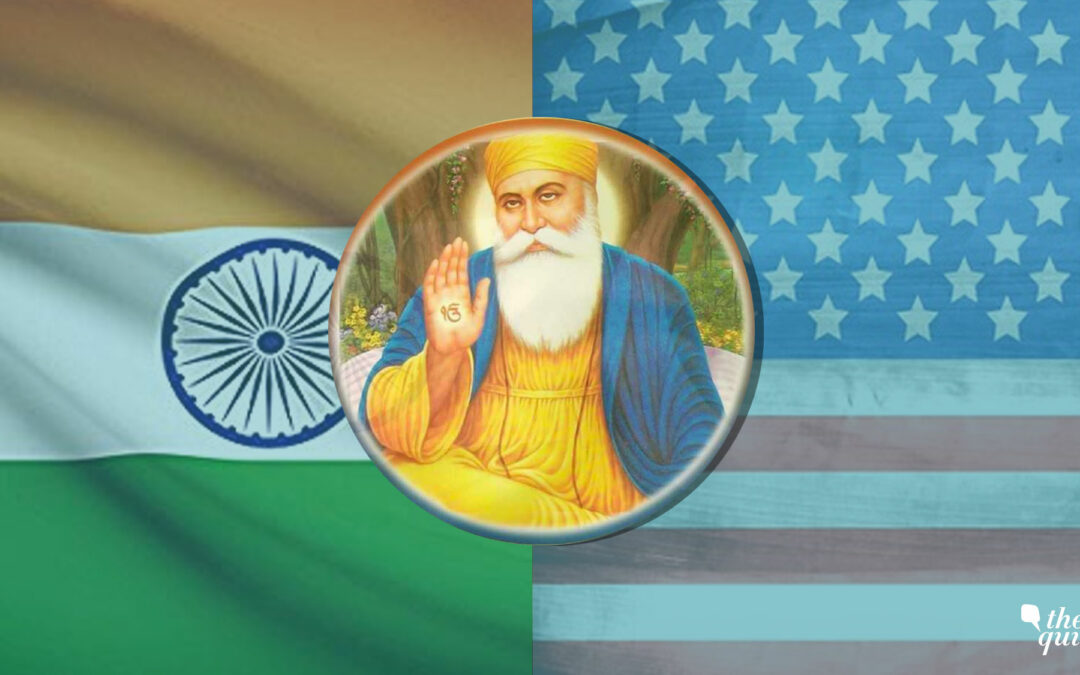
by blogadmin | May 13, 2019 | Blog Post, Delaware, Media Publishing's, Sikhism, Year 2019
Years ago, I was at a college classmate’s house in my hometown, Patiala. His retired colonel neighbor asked me, where in the United States I lived. “Delaware,” I replied.
“Umm…Where?”
I repeated, slowly, “Delaware.”
The colonel narrowed his eyes, picked up his large tumbler of some strong drink, (rum, probably), gulped it in one go, and said, “Delaware…huh? What kind? Software or hardware?”
Could this ignorance, coupled with bigotry, have led to the killing of three Sikh women and a Sikh man at an apartment complex in Ohio’s Cincinnati city, on 30 April? While External Affairs Minister Sushma Swaraj had said that this was “not a hate crime”, questions continue to linger amid investigation into the case.
Is it possible that the Sikh family was more vulnerable (in the eyes of the perpetrators) because they were Sikhs / Asians?
Sikh Diaspora in Delaware & Cultural Diversity
Almost all the South Asians living in Delaware are first generation immigrants. As long as they could eat their rice or rotis at home, their cultural and religious aspirations rarely superseded family and economic priorities. Therefore, I was amazed to see a huge (and diverse) turnout at Lalkar 2019 , a national collegiate bhangra and fusion dance competition. From the 62 university teams that had applied, eight teams were selected to perform at the University of Delaware.
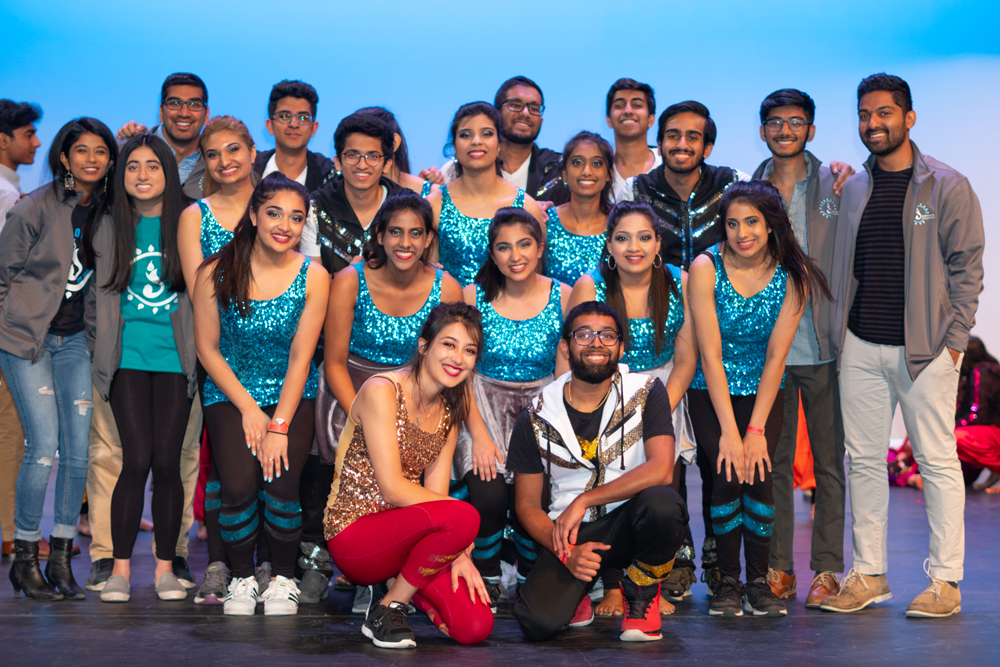
Significantly, the event’s success was a true tribute to the message of Guru Nanak in his 550th birth year—bringing people together in respect, peace and love.

On 19 March, the Delaware Sikh Awareness Coalition (DSAC) organised a luncheon in Dover, the capital of Delaware. It was before we went to the state Legislative Hall, where the Senate and the House were scheduled to pass a concurrent resolution, declaring April 2019 as ‘Delaware’s Sikh Awareness and Appreciation Month’.
The participants at the luncheon were a diverse lot, and included men and women as young as 16 and as old as 86. Those originally from India included Gujaratis, Punjabis, Sindhis, Delhiwallahs, UP, Bihar, MP, and many from the southern part of India. Among the Americans there were people across Christian denominations, and one Jew.
Various community leaders, legislators and individuals of different castes, colour, abilities and professions were in the audience. Many of them even took the opportunity to experience wearing a Sikh turban.
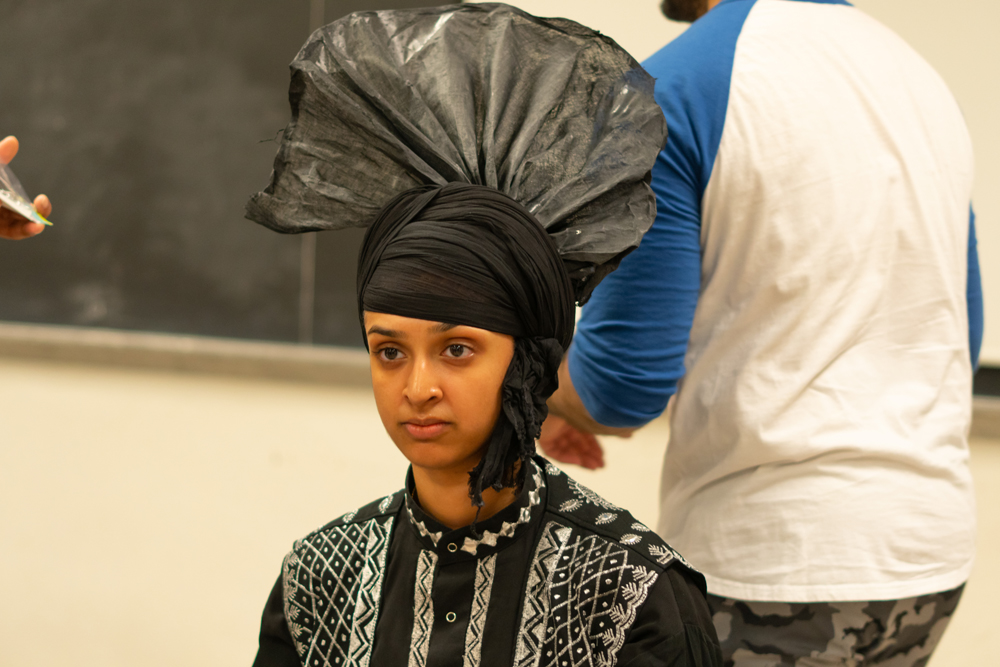
‘Why a Real Tribute to Guru Nanak Should Be An Interfaith Celebration’
The topic of discussion at the luncheon was ‘Why a real tribute to Guru Nanak’s 550th should be an interfaith celebration’. Most had never even heard of Guru Nanak.
Starting from the “Na ko Hindu, Na Musalman” (No one is Hindu, no one is Muslim) proclamation after his communion with God in 1499, Guru Nanak used art (writing hymns in divine poetry) and music to take his message of Ek Onkar (all creation by one creator) to the world. Along with two companions, Bhai Bala and Bhai Mardana – the latter playing the rubab – Guru Nanak used melody and music to spread his message.
His successors temporally and spiritually built on the foundations of peace and communal harmony that Guru Nanak had laid.
Among the 36 were Baba Sheikh Farid, Bhagat Namdev, Sant Kabir (the maximum contribution by a non-Guru author and the fifth largest among all authors), Bhagat Ravidas, Bhagat Kalshar, Bhagat Nalh.
The holy text also depicts the importance of dissent, and that too, respectful dissent. On page 1380 of the Sri Guru Granth Sahib, Guru Amar Das disagrees with Baba Farid ji after more than 250 years, and the divine dialogue is presented in a sublime way. In fact, Farid ji’s bani (hymn) is in the Sri Guru Granth Sahib, before which millions bow their heads every day. This also depicts the virtue of tolerance and regard for all, that Sikhism embodies.
What Guru Nanak Truly Wanted
At the end of the presentation, a slide show on Harmandir Sahib, whose foundation was laid by Sufi saint Mian Mir Sahib, was presented – to further illustrate the point of communal harmony and religious tolerance. Post-luncheon, we went to the Legislative Hall where Delaware Senator, Bryan Townsend, introduced the resolution in the Senate, and Representative Paul Baumbach introduced it in the House. It was unanimously passed in both the chambers. Governor John Carney signed an executive proclamation, declaring April 2019 as ‘Delaware Sikh Awareness and Appreciation Month’.
This was the third year in a row that this feat was accomplished. But what made this edition stand out is the participation of diverse groups, across communities. This is what we believe, Guru Nanak really wanted.
– – – – – – –
This column was published online by the www.thequint.com on May 13, 2019.

by blogadmin | Dec 24, 2018 | Blog Post, Delaware, Media Publishing's, Year 2018
It was in the dark room of our home in Punjab’s Daroli Khurd village where I was midwifed into this world.
I grew up hearing the light-bearing tales and fables of Punjab’s haloed warriors, freedom fighters and sportsmen. We had started living in Patiala by the time our farmers too had sort of joined the ‘celebrity league’ for ushering in the green revolution.
However, the common thread running through these legends showed itself to me only after I reached Lancashire, England. I was there in the mid-1990s to pursue a master’s degree in business, after completing my undergraduate degree in computer science, which was followed by a couple of years of work in Dilli.
In England, I met legions of Punjabis (Hindus, Sikhs and Muslims) who had arrived in their much cherished Vilayat in the 1950s and 60s to work in the cotton mills—once the pride of Britain. The majority of them now faced the challenge of finding a job. The resulting crisis of financial distress and low self-esteem was proving to be a fertile ground for sprouting the social and addiction problems I saw in abundance.
Except for the urban post-millennials (Generation Z)—maybe—who in Punjab doesn’t remember the glowing aura these Vilayatis carried in the land not too long ago? Their presence in the village, street or neighborhood was synonymous with Mauja hi Mauja!
But when their career and economic situation became tough in the meman-di-land, they, in actual fact, had nothing more than their tall and handsome physiques, and physical bravery to offer—the same attributes that had catapulted the heroes of the light-bearing, myth-like stories.
Undoubtedly and unfortunately, it was not only in the time of Tennyson, but even then, that the old order was yielding its place to the new. These physical talents were no longer an asset for them to earn an honourable living and a dignified life.
What began as a trickle soon became a creek, and then a river. These newly arrived ‘e-pilgrims’ in America were IT—overwhelmingly software—workers.
Of Limo Pick-Ups & Easy H1B Visas
While Punjabis remained busy finding reliable Aagants and arranging large sums of money somehow (illegally) to place foot in Amrika, American companies were busy convincing software techs in Bangalore and Hyderabad why they should join them and not their competitors.
Limousines were sent to pick them up from the airports. Hotel stays were arranged and provided for, for the first two weeks or more, as temporary living quarters. Other needs were catered to as well including classes in American English and cultural familiarity.
I know that what you read nowadays about H1B’s is far different from this glorious account. Yes, that is so over, and so much more over now than when the dot-com obsession was around. It started to fade in 2000. Then it simply disappeared after the 9/11 tragedy. Nevertheless, for the IT industry and the Indians, in hindsight, it was just a cyclical trough. They were back in demand as the US economy began to reboot after several months of downtime.
How H1B Troubles Began in US
The internet became ubiquitous. The entrepreneurs and visionaries in the US kept working to create applications, packages, products and platforms around the internet that changed how entities interact, communicate and transact business.
It was my second job after returning from England. The first one was in Bangalore. Over two decades, I have done thousands of H1Bs and green cards and know a thing or two about them. First, all the problems are not just because of Trump (although I only feel happy when he is blamed for them).
The Trump regime is happily implementing further changes through memos and interim regulations.
The Need for More ‘Jugaad’
Individuals still carry the worker mindset. Brought up in India on an overdose of the “silence is golden” principle, they are struggling to add value in the current agile environment, where communication and punctuality carry premiums.
Notwithstanding their claims to the contrary, the much-respected and admired Indian software companies are still largely “body shopping boutiques”. I say “largely” only out of my love for them.
I have nothing against their hunger to create land banks for robust share value, but they should have shown the same jugaadbaji (innovation) in creating products, applications, platforms, and a culture of creativity and innovation.
Nonetheless, I wholeheartedly lend my voice to their 2020 resolution: Trump Bin, Acche Din!
– – – – – – – –
This column was published online by the www.thequint.com on Dec 24, 2018.
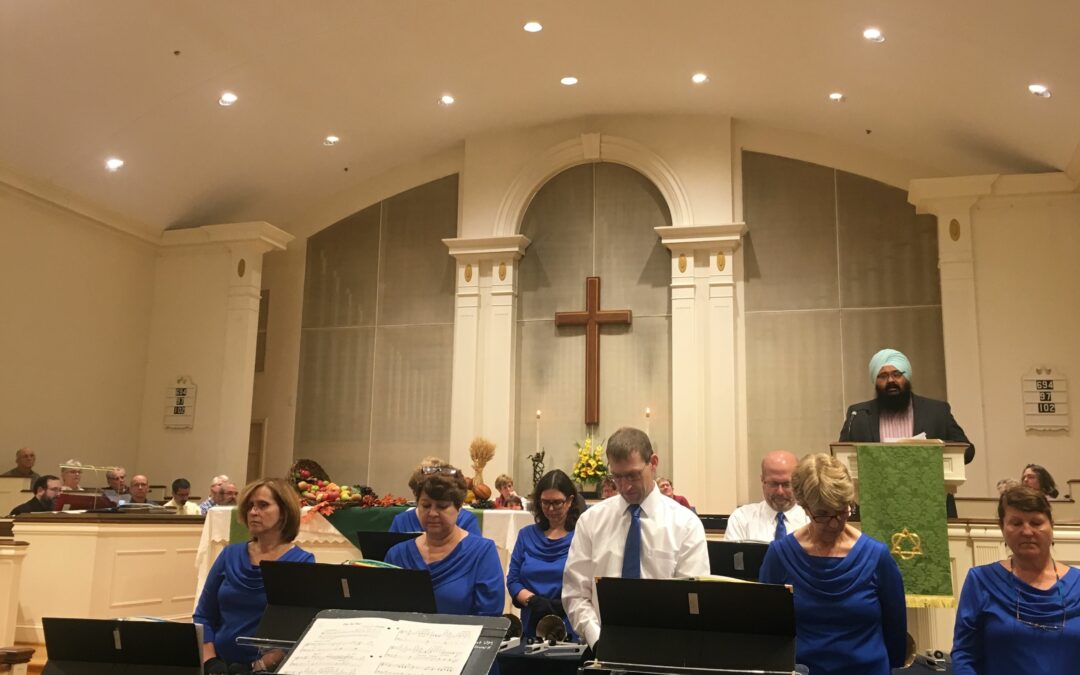
by blogadmin | Dec 11, 2018 | Blog Post, Delaware, Media Publishing's, Sikhism, Year 2018
It was the morning of the Thursday (15 November) before — one full week before Turkey Day, an informal way we here in America refer to Thanksgiving. It was snowing outside. Delaware National Guard’s 36th Annual Prayer Breakfast was that same morning, and I was among the invited.
Like a pucca Indian, when I reached the venue, Cavaliers Country Club, others were about to finish eating. I was courteously led to my designated table after I showed the reception staff my driver’s license to help them out of the struggle with my name.
My friends, (Rev.) Tom Davis and Jack Sanders, got up to give me a hug. Among the others at the same table was Chaplain (Lt Col) Andy Werner, who I later learnt had started this wonderful tradition. He had paid for my breakfast, too. I blessed him even more for that.
In the large hall were men and women in uniform and, of course, the chaplains, most of them in uniform as well, making me wonder if their divine approach was any different from their civilian counterparts.
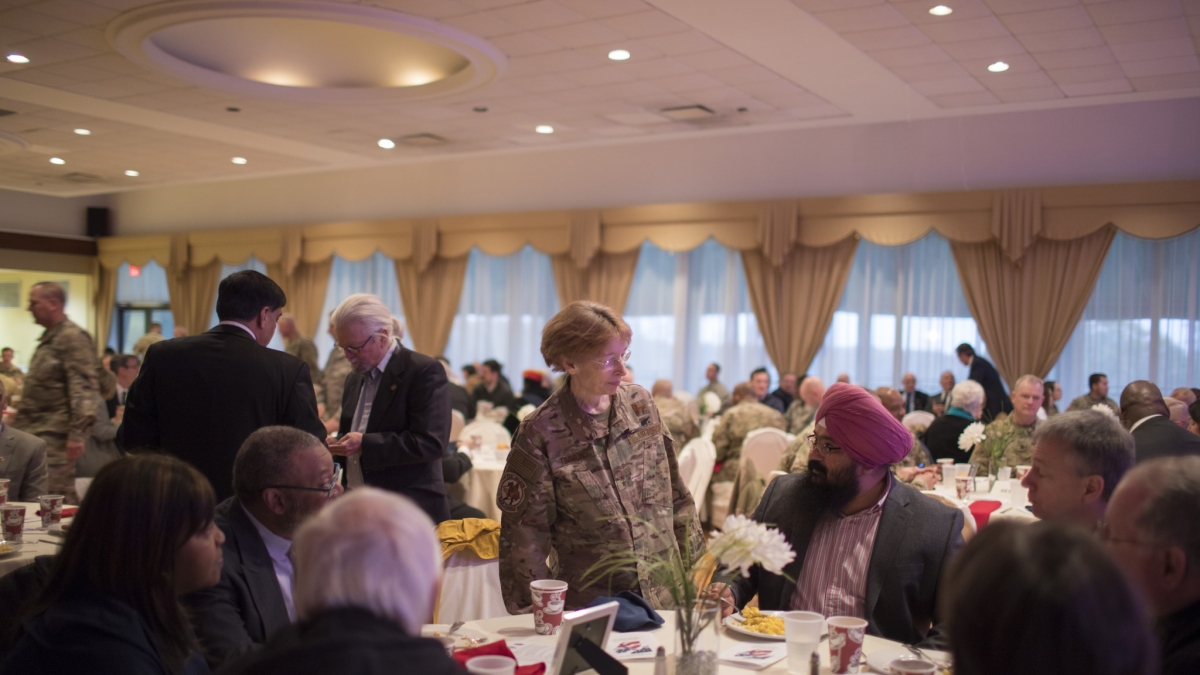 The woman who came to greet us at the table was the Adjutant General, the official host of the event.
The woman who came to greet us at the table was the Adjutant General, the official host of the event.
The woman who came to greet us at the table was the Adjutant General, the official host of the event. The only other person I could recognise was Delaware Governor John Carney when he greeted me. We were later informed that representatives of the state’s Congressional delegation were there too.
Driving back, I wondered about the various ways Americans celebrate Thanksgiving. Some start with a great breakfast followed by an evening feast of turkey, cranberry sauce and green bean casserole.
In India and most other countries, such joyous feasting and festivity is reserved for religious events. But this great American festival is for everyone, including those who have no faith or don’t believe in Rab-ji! (God).
Here, we have had our own tradition since 1992. People of different religions in our area come together at an inter-faith Thanksgiving prayer. Clergy members (I am an exception) of different faiths and denominations speak at the event. More than two hundred people attend year after year.
I have been associated with this great tradition from several years. It started when I first attended one of the group’s monthly meetings as a representative of the local Sikh community.
Members of the group have joined me in the last two inter-faith peace walks as part of the Delaware Sikh Awareness and Appreciation Month. The Delaware Sikh Awareness Coalition (DSAC) — which I founded and chair — organised the DSAAM resolutions as well as the peace walks in April of 2017 and 2018.
The DSAC also has received tremendous help and support from Rev Cynthia Robinson (my dear “sister”) of the New Ark United Church of Christ. She even knows a couple of Hindi words, learned from her aunt who was a missionary in India — including Batala in Punjab — for several years. One of them is shabash,which Cynthia not only uses appropriately but wonderfully.
Last year, when I shared with fellow speakers and the audience why Thanksgiving has this special connection for me, I was mobbed at the end by people to further explain to them the grand idiom of positivity and prosperity — Sarbat Da Bhala!
I told them that every Sikh prayer I had ever heard or read ended with Sarbat Da Bhala, regardless of the occasion, day or time. However, I considered it a religious formality without real life application.
Then I came to America and experienced Thanksgiving. That’s when the bulb in my mind lit up and I understood, for the first time, that the spirit of Sarbat Da Bhalaalso has practical applications in real life. The native Americans didn’t help the pilgrims because they spoke the same language or had the same colour or because their religions were the same.
And they certainly did not support the same cricket team, nor did their wives belong to the same kitty group. I am sure their kids didn’t go to the same high school, I told them. For me it was simply a living example of Sarbat Da Bhala! It was the embodiment of the divine saying.
And so, I am sure my “sister” Cynthia will not mind when I borrow her word to say, “Shabash Thanksgiving!”
– – – – – – –
This column was published online by the www.thequint.com on Dec 01, 2018 & www.delawareonline.com on Dec 10, 2018.










 The woman who came to greet us at the table was the Adjutant General, the official host of the event.
The woman who came to greet us at the table was the Adjutant General, the official host of the event.
Recent Comments